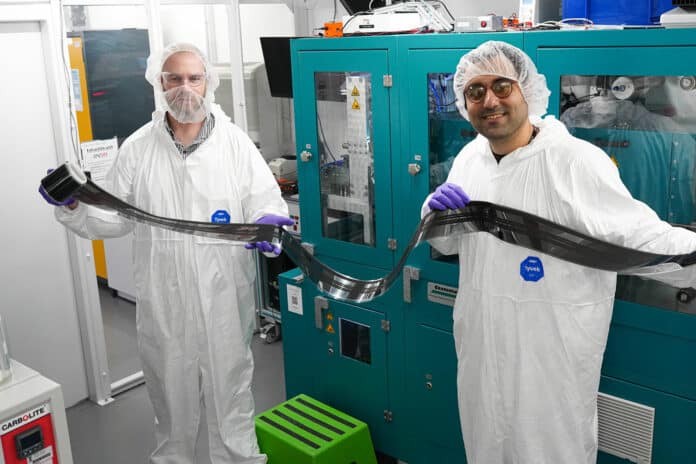Perovskite photovoltaics have shown great promise in device efficiency but also the promise of scalability through solution-processed manufacture. Efforts to scale perovskites have been taken through printable mesoporous scaffolds and slot die coating of flexible substrates roll-to-roll (R2R).
However, to date, there has been no demonstration of entirely R2R-coated devices due to the lack of a compatible solution-processable back electrode; instead, high-value evaporated metal contacts are employed as a post-process.
Engineers from the SPECIFIC Innovation and Knowledge Centre at Swansea University have established a low-cost and scalable carbon ink formulation capable of unlocking, for the first time, the potential for perovskite solar cells to be manufactured at scale.
Researchers used slot die coating in a roll-to-roll (R2R) process to develop a “fully printable” perovskite photovoltaics (PV). They searched for an alternative to the gold electrode that is typically applied using an expensive and slow evaporation process after the device has been printed.
“The key was identifying the right solvent mix, one which dries as a film without dissolving the underlying layer,” said Dr. David Beynon, Senior Research Officer at SPECIFIC. “X-ray diffraction analysis showed carbon electrode ink is capable of this when formulated with an orthogonal solvent system. This innovative layer can be applied continuously and compatibly with the underlying layers at a low temperature and high speed.”
The new fully R2R-coated device was printed onto a 20-meter-long flexible substrate. In the lab tests, the devices with carbon electrodes provided similar photovoltaic performance to the conventional evaporated gold electrodes. In particular, the results showed that the small-scale device efficiencies of 13-14% are achieved, matching the device performance of evaporated gold electrodes.
The additional benefits include outperforming at higher temperatures and having better long-term stability. Also, this entirely R2R-coated perovskite prototype reached over 10% (10.8) stabilized power conversion efficiency with unencapsulated long-term stability retaining 84% of its original efficiency over 1000 hours.
“The next challenge in printed PV for us at Swansea University is to prove to people that these work,” Professor Watson said. “In order to achieve this, we need to start making something that really looks like a solar panel. We can then install them on buildings and understand how close we are to delivering on the promise of UK-based manufacturing of green renewables.”
Journal reference:
- David Beynon, Ershad Parvazian, Katherine Hooper, James McGettrick, Rahul Patidar, Tom Dunlop, Zhengfei Wei, Peter Davies, Rodrigo Garcia-Rodriguez, Matt Carnie, Matthew Davies, Trystan Watson. All-Printed Roll-to-Roll Perovskite Photovoltaics Enabled by Solution-Processed Carbon Electrode. Advanced Materials, 2023; DOI: 10.1002/adma.202208561
